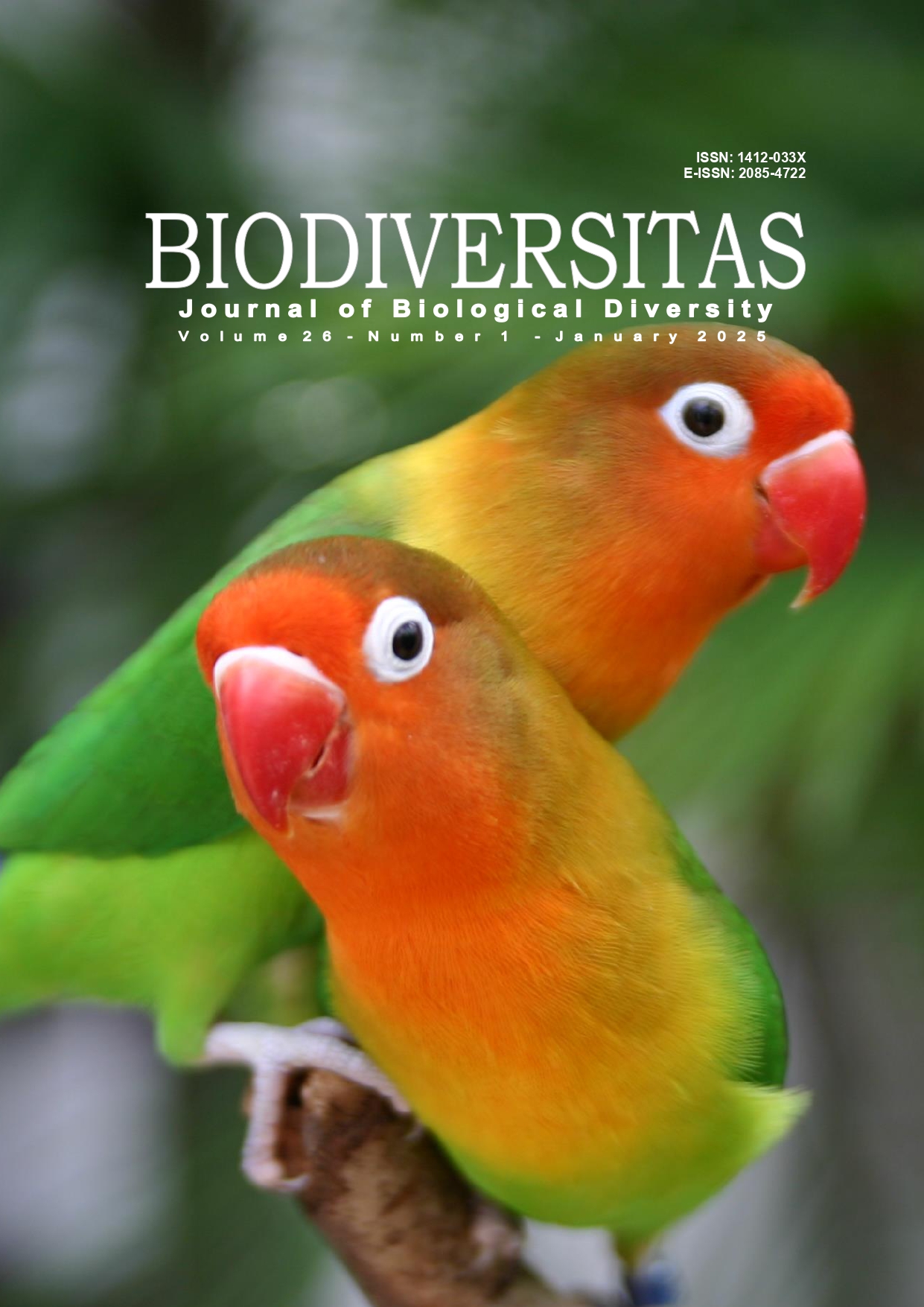The study of diversity and distribution of bats in several fragmented forests and small adjacent islands in Batam City, Riau Island, Indonesia
##plugins.themes.bootstrap3.article.main##
Abstract
Abstract. Syamsi F, Novarino W, Dahelmi, Chairul. 2025. The study of diversity and distribution of bats in several fragmented forests and small adjacent islands in Batam City, Riau Island, Indonesia. Biodiversitas 26: 223-232. Bats are ecologically and taxonomically diverse and crucial in tropical ecosystems, including on islands. This study compares bat diversity in fragmented forests on urban islands and adjacent islands connected by bridges to assess the impact of urbanization on bat populations, providing insights for conservation and habitat management. We sampled bats across four sites in Batam City, Indonesia, including two secondary forests (SF1 and SF2) and two small islands (SI1 and SI2). Using 120 harp trap nights and 120 net nights, we captured 429 bats representing 15 species and 4 families. Our findings revealed moderate bat diversity (H' 1.02 to 1.66), with SF1 being the most stable habitat, showing balanced species richness, evenness (0.72), and low dominance (0.24), indicating an evenly distributed community. The Bray-Curtis Similarity index indicated that SF1 had a distinct bat community with only 58% similarity to other habitats. Notably, two near-threatened species were found in SF1, emphasizing its ecological significance. The study suggests that fragmented forests with healthy vegetation and habitat complexity surrounding urban areas are more supportive of bat populations than small islands with limited resources. These results highlight the need for targeted conservation efforts in forest fragments surrounding urban areas to preserve bat diversity in Batam City, Riau Island, Indonesia.
##plugins.themes.bootstrap3.article.details##
Most read articles by the same author(s)
- ASHRIFURRAHMAN, SARUEDI SIMAMORA, RUSDIYAN RITONGA, WILSON NOVARINO, DJONG HON TJONG, RIZALDI, SYAIFULLAH, DEWI IMELDA ROESMA, Sumatran tiger identification and phylogenetic analysis based on the CO1 gene: Molecular forensic application , Biodiversitas Journal of Biological Diversity: Vol. 23 No. 4 (2022)
- MUHAMMAD AZHARI AKBAR, RIZALDI RIZALDI, WILSON NOVARINO, DYAH PERWITASARI-FARAJALLAH, YAMATO TSUJI, Short Communication: Activity budget and diet in silvery lutung Trachypithecus cristatus at Gunung Padang, West Sumatra, Indonesia , Biodiversitas Journal of Biological Diversity: Vol. 20 No. 3 (2019)
- AIDA FITRIANI SITOMPUL, ELIDA HAFNI SIREGAR, DEWI IMELDA ROESMA, DAHELMI DAHELMI, EKO PRASETYA, Molecular identification of coffee (Coffea arabica) pollinator insects in North Sumatra, Indonesia based on designed COI primers , Biodiversitas Journal of Biological Diversity: Vol. 19 No. 5 (2018)
- IKRIMA ASRORI, DJONG HON TJONG, WILSON NOVARINO, MANSYURDIN, SYAIFULLAH, DEWI IMELDA ROESMA, DNA primer design for sex identification of Sumatran tiger body samples , Biodiversitas Journal of Biological Diversity: Vol. 24 No. 1 (2023)
- CHAIRUL CHAIRUL, PRAPTIWI PRAPTIWI, SOFNIE MARUSIN CHAIRUL, Phagocytosis Effectivity Test of Phenylbutenoid Compounds Isolated from Bangle (Zingiber cassumunar Roxb.) Rhizome , Biodiversitas Journal of Biological Diversity: Vol. 10 No. 1 (2009)
- PRAPTIWI PRAPTIWI, MINDARTI HARAPINI, CHAIRUL CHAIRUL, Antimalaria in-vivo activity test of ki pahit extract (Picrasma javanica) to mice infected with Plasmodium berghei , Biodiversitas Journal of Biological Diversity: Vol. 8 No. 2 (2007)
- SOLFIYENI SOLFIYENI, ERIZAL MUKHTAR, SYAMSUARDI SYAMSUARDI, CHAIRUL CHAIRUL, Distribution of invasive alien plant species, Bellucia pentamera, in forest conservation of oil palm plantation, West Sumatra, Indonesia , Biodiversitas Journal of Biological Diversity: Vol. 23 No. 7 (2022)
- SOLFIYENI, SYAMSUARDI, CHAIRUL, ERIZAL MUKHTAR, Impacts of invasive tree species Bellucia pentamera on plant diversity, microclimate and soil of secondary tropical forest in West Sumatra, Indonesia , Biodiversitas Journal of Biological Diversity: Vol. 23 No. 6 (2022)
- WILSON NOVARINO, ERIZAL MUKHTAR, AYU SMARNIA PUTRI, PUTRI LISYA ANGGRAINI, Bird diversity and mangrove forest as potential ecotourism destinations in Kapo-kapo Bay, Cubadak Island, West Sumatra, Indonesia , Biodiversitas Journal of Biological Diversity: Vol. 24 No. 6 (2023)
- PRAPTIWI PRAPTIWI, CHAIRUL CHAIRUL, The effect of pauh kijang (Irvingia malayana Oliv ex. A. Benn) in decreasing parasitemia percentage in mice infected with Plasmodium berghei , Biodiversitas Journal of Biological Diversity: Vol. 9 No. 2 (2008)

